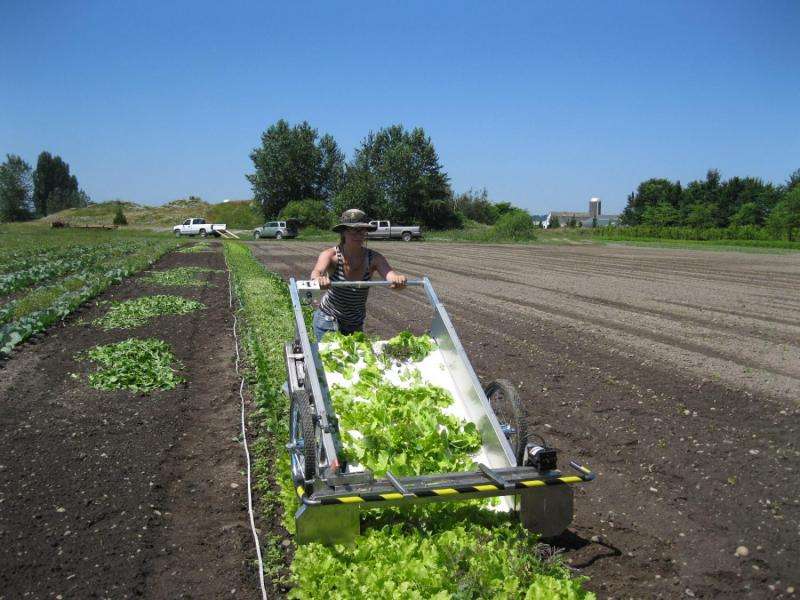One of the authors of a new study is shown harvesting baby-leaf greens in a field in Washington. Field experiments revealed ways growers can lengthen production seasons for popular salad greens. Credit: Carol Ann Miles.
Ready-to-eat salad mixes have experienced a tremendous increase in popularity and sales over the last 20 years. A study in HortScience reports that supermarket sales of the produce increased from $197 million in 1993 to $2.7 billion in 2008 in the U.S. Looking for ways to meet consumer demand and extend the production season of popular baby-leaf salad greens in the Pacific Northwest, scientists in Washington evaluated salad cultivars for suitability as spring and fall crops.
"There is strong demand in northwest Washington for locally grown baby-leaf salad greens," said Carol Miles, from the Department of Horticulture at Washington State University, corresponding author of the study. "While the market is well supplied throughout the summer in this region, growers require production information to enable them to extend the season as much as possible in the spring and fall." Miles and researchers Charlene Grahn, Chris Benedict, and Tom Thornton evaluated nine salad crop cultivars for suitability as baby-leaf salad greens in the spring (April-June) and six cultivars for the fall (September-November) growing seasons in northwest Washington. Trials were conducted at Cloud Mountain Farm Center in Everson, and Washington State University's Northwestern Washington Research and Extension Center in Mount Vernon.
The scientists found interactions between year, season, location, planting date, and cultivar for all crop parameters recorded (marketable crop weight, days to harvest, and ability to compete with weeds). They said that these results suggest that "environmental conditions and phenotypic plasticity play an important role in the performance of baby-leaf salad crops."
In the spring growing season, cultivars had higher marketable weight and shorter days to harvest than in the fall season. Overall, pak choi 'Joi Choi' had a high marketable weight, a relatively quick time to harvest, and high weed competitiveness. Mustard 'Komatsuna' also had one of the highest marketable weights, as well as the lowest days to harvest and highest weed competitiveness.
Beet 'Bull's Blood' showed a consistently low weight, relatively long days to harvest, and poor weed competitiveness. 'Brown Goldring', a romaine-type lettuce commonly grown for baby-leaf salad, had the longest overall days to harvest. "Because lettuce is one of the most desirable crops for salad mix, there is a need to identify cultivars that are well suited to extended season production," the authors said.
The report recommends that growers in the region plant a diverse array of crops for baby-leaf salad to protect from crop loss and realize overall yield stability.
More information: The complete study and abstract are available on the ASHS HortScience electronic journal web site: hortsci.ashspublications.org/c … /50/10/1467.abstract
Journal information: HortScience
Provided by American Society for Horticultural Science





















